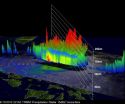(Press-News.org) CAMBRIDGE, MA -- From an engineer's perspective, plants such as palm trees, bamboo, maples and even potatoes are examples of precise engineering on a microscopic scale. Like wooden beams reinforcing a house, cell walls make up the structural supports of all plants. Depending on how the cell walls are arranged, and what they are made of, a plant can be as flimsy as a reed, or as sturdy as an oak.
An MIT researcher has compiled data on the microstructures of a number of different plants, from apples and potatoes to willow and spruce trees, and has found that plants exhibit an enormous range of mechanical properties, depending on the arrangement of a cell wall's four main building blocks: cellulose, hemicellulose, lignin and pectin.
Lorna Gibson, the Matoula S. Salapatas Professor of Materials Science and Engineering at MIT, says understanding plants' microscopic organization may help engineers design new, bio-inspired materials.
"If you look at engineering materials, we have lots of different types, thousands of materials that have more or less the same range of properties as plants," Gibson says. "But here the plants are, doing it arranging just four basic constituents. So maybe there's something you can learn about the design of engineered materials."
A paper detailing Gibson's findings has been published this month in the Journal of the Royal Society Interface.
To Gibson, a cell wall's components bear a close resemblance to certain manmade materials. For example, cellulose, hemicellulose and lignin can be as stiff and strong as manufactured polymers. A plant's cellular arrangement can also have engineering parallels: cells in woods, for instance, are aligned, similar to engineering honeycombs, while polyhedral cell configurations, such as those found in apples, resemble some industrial foams.
To explore plants' natural mechanics, Gibson focused on three main plant materials: woods, such as cedar and oak; parenchyma cells, which are found in fruits and root vegetables; and arborescent palm stems, such as coconut trees. She compiled data from her own and other groups' experiments and analyzed two main mechanical properties in each plant: stiffness and strength.
Among all plants, Gibson observed wide variety in both properties. Fruits and vegetables such as apples and potatoes were the least stiff, while the densest palms were 100,000 times stiffer. Likewise, apples and potatoes fell on the lower end of the strength scale, while palms were 1,000 times stronger.
"There are plants with properties over that whole range," Gibson says. "So it's not like potatoes are down here, and wood is over there, and there's nothing in between. There are plants with properties spanning that whole huge range. And it's interesting how the plants do that."
It turns out the large range in stiffness and strength stems from an intricate combination of plant microstructures: the composition of the cell wall, the number of layers in the cell wall, the arrangement of cellulose fibers in those layers, and how much space the cell wall takes up.
In trees such as maples and oaks, cells grow and multiply in the cambium layer, just below the bark, increasing the diameter of the trees. The cell walls in wood are composed of a primary layer with cellulose fibers randomly spread throughout it. Three secondary layers lie underneath, each with varying compositions of lignin and cellulose that wind helically through each layer.
Taken together, the cell walls occupy a large portion of a cell, providing structural support. The cells in woods are organized in a honeycomb pattern — a geometric arrangement that gives wood its stiffness and strength.
Parenchyma cells, found in fruits and root vegetables, are much less stiff and strong than wood. The cell walls of apples, potatoes and carrots are much thinner than in wood cells, and made up of only one layer. Cellulose fibers run randomly throughout this layer, reinforcing a matrix of hemicellulose and pectin. Parenchyma cells have no lignin; combined with their thin walls and the random arrangement of their cellulose fibers, Gibson says, this may explain their cell walls' low stiffness. The cells in each plant are densely packed together, similar to industrial foams used in mattresses and packaging.
Unlike woody trees that grow in diameter over time, the stems of arborescent palms such as coconut trees maintain similar diameters throughout their lifetimes. Instead, as the stem grows taller, palms support this extra weight by increasing the thickness of their cell walls. A cell wall's thickness depends on where it is along a given palm stem: Cell walls are thicker at the base and periphery of stems, where bending stresses are greatest.
Gibson sees plant mechanics as a valuable resource for engineers designing new materials. For instance, she says, researchers have developed a wide array of materials, from soft elastomers to stiff, strong alloys. Carbon nanotubes have been used to reinforce composite materials, and engineers have made honeycomb-patterned materials with cells as small as a few millimeters wide. But researchers have been unable to fabricate cellular composite materials with the level of control that plants have perfected.
"Plants are multifunctional," Gibson says. "They have to satisfy a number of requirements: mechanical ones, but also growth, surface area for sunlight and transport of fluids. The microstructures plants have developed satisfy all these requirements. With the development of nanotechnology, I think there is potential to develop multifunctional engineering materials inspired by plant microstructures."
INFORMATION: END
It's become a sport of sorts, predicting the low point of Arctic sea ice each year. Expert scientists with decades of experience do it but so do enthusiasts, whose guesses are gamely included in a monthly predictions roundup collected by Sea Ice Outlook, an effort supported by the U.S. government.
When averaged, the predictions have come in remarkably close to the mark in the past two years. But the low and high predictions are off by hundreds of thousands of square kilometers.
Researchers are working hard to improve their ability to more accurately predict how much ...
Girls with Attention Deficit Hyperactivity Disorder (ADHD) – and their families – often look forward to the likely decline in visible symptoms such as fidgety or disruptive behavior as they mature into young women.
However, new findings from UC Berkeley caution that, as they enter adulthood, girls with histories of ADHD are more prone to internalize their struggles and feelings of failure – a development that can manifest itself in self-injury and even attempted suicide.
"Like boys with ADHD, girls continue to have problems with academic achievement and relationships, ...
An intensifying Tropical storm called Kai-Tak (locally known as Helen) is causing more rain in the Philippines as it passes over northern Luzon. The Philippines have had a very wet month with the capital of Manila experiencing massive flooding earlier this month. NASA's TRMM satellite identified where the heavy rain was falling.
Kai-tak has caused another day of warnings in the Philippines. On August 14, Public storm warning signal #1 is in effect for these provinces in Luzon: La Union, Nueva Ecija, Pangasinan, Rest of Aurora, and Tarlac.
In addition, Public storm warning ...
Tropical Storm Hector is battling wind shear over the open waters of the Eastern Pacific Ocean, and NASA satellite data shows that has been affecting its organization and rainfall rates.
The Tropical Rainfall Measuring Mission satellite known as TRMM is managed by both NASA and the Japanese Space Agency. From its orbit in space, TRMM's instruments can estimate rainfall from tropical cyclones.
The TRMM satellite captured rainfall rates from Tropical Storm Hector on August 14, 2012 1:28 a.m. EDT. TRMM data showed that Hector had a small area of moderate to heavy rainfall ...
VIDEO:
Filmed at 10,000 frames per second by Japan's NHK television, movies like this of electromagnetic bursts called "sprites " will help scientists better understand how weather high in the atmosphere relates...
Click here for more information.
High above the clouds during thunderstorms, some 50 miles above Earth a different kind of lightning dances. Bursts of red and blue light, known as "sprites," flash for a scant one thousandth of a second. They are often ...
Many elderly people spend their last years alone. Spouses pass and children scatter. But being lonely is much more than a silent house and a lack of companionship. Over time, loneliness not only takes a toll on the psyche but can have a serious physical impact as well.
Feeling lonely has been linked to an increased risk of heart disease, Alzheimer's disease, depression and even premature death. Developing effective treatments to reduce loneliness in older adults is essential, but previous treatment efforts have had limited success.
What to do? Researchers at UCLA ...
In 1714, the British government held a contest. They offered a large cash prize to anyone who could solve the vexing "longitude problem" — how to determine a ship's east/west position on the open ocean — since none of their naval experts had been able to do so.
Lots of people gave it a try. One of them, a self-educated carpenter named John Harrison, invented the marine chronometer — a rugged and highly precise clock — that did the trick. For the first time, sailors could accurately determine their location at sea.
A centuries-old problem was solved. And, arguably, crowdsourcing ...
Two researchers at Weill Cornell Medical College have deciphered a mouse's retina's neural code and coupled this information to a novel prosthetic device to restore sight to blind mice. The researchers say they have also cracked the code for a monkey retina — which is essentially identical to that of a human —and hope to quickly design and test a device that blind humans can use.
The breakthrough, reported in the Proceedings of the National Academy of Sciences (PNAS), signals a remarkable advance in longstanding efforts to restore vision. Current prosthetics provide blind ...
Tiny space age probes — those that can see inside single living cells — are increasingly being used to diagnose illness in hard-to-reach areas of the body.
NewYork-Presbyterian Hospital/Weill Cornell Medical Center's Dr. Michel Kahaleh often threads a tiny microscope into the narrow bile ducts that connect the liver to the small intestine to hunt for cancer. He also uses the device to minutely explore the pancreatic duct as one of a few doctors in the country to use such technology in this way.
But because these devices are comparatively new, Dr. Kahaleh, chief of ...
SEATTLE – Yo-yo dieting – the repetitive loss and regain of body weight, also called weight cycling – is prevalent in the Western world, affecting an estimated 10 percent to 40 percent of the population. The degree to which weight cycling may impact metabolism or thwart a person's ability to lose weight in the long run has been unclear – until now.
A new study by researchers at Fred Hutchinson Cancer Research Center, published online in the journal Metabolism, for the first time has shown that a history of yo-yo dieting does not negatively affect metabolism or the ability ...

